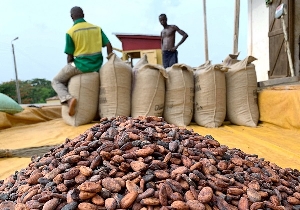 Cocoa is a key export commodity for Ghana
Cocoa is a key export commodity for Ghana
Cocoa exports plunged in the first quarter of 2024 – dampening growth of the country’s trade surplus, fresh data have shown.
While the surplus is widening in nominal terms, this has been mainly due to rising prices rather than increased exports or economic expansion.
Data released by the Ghana Statistical Service (GSS) reveal the country’s export value of cocoa products in the first quarter of 2024 (Q1) slid to just US$592.2million – down sharply from an average of US$825.8million in the comparable period last year and prior two opening quarters.
It marks the lowest quarterly cocoa export value for the second-largest producer since 2021.
Industry regulator Cocoa Board (Cocobod) said on March 25 that Ghana’s 2023/24 cocoa harvest would be only 422,500 metric tonnes (MT) to 425,000 MT – half the country’s initial forecast and a 22-year low – as extreme weather and disease decimated the cocoa crop.
Concerns about the West African mid-crop, the smaller of two annual harvests, are also leading to tightness in cocoa supplies on the world market. Projections for the Ghana mid-crop, which starts in July, have been cut to 25,000 MT compared with an earlier forecast of 150,000 MT.
The cocoa slump comes despite the country posting a Q1 2024 trade surplus of GH¢11.5billion (US$1.35billion), more than double the GH¢4.5billion surplus a year earlier.
But GSS officials cautioned the rosy trade numbers obscure an underlying lack of real trade growth once prices are accounted for.
“In real terms, our trade value in Q1 2024 was just GH¢47billion after discounting price effects – less than half the nominal GH¢107.6billion figure,” Professor Samuel Kobina Annim, Government Statistician, said at the data release.
“About GH¢59billion of our nominal trade value was from price changes alone,” he added.
The diverging real and nominal trade trajectories reflect a new import and export price index launched by GSS.
It shows general export prices surged 20.4 percent between Q1 2023 and Q1 2024, while import prices jumped 11.5 percent.
Prices for key commodities like gold, cocoa and fuel have uptrended in the past year amid supply shocks and currency fluctuations.
After adjusting for those price swings, real trade volumes increased just 0.6 times from Q1 2021 to Q1 2024 – paling in comparison to the 2.4-fold nominal spike, data showed.
Trade officials acknowledged the trend of price-driven, not output-driven, trade growth is concerning.
“If our exports are mainly driven by price changes, it means in real terms our trade volumes aren’t really growing – and that’s not what we want. We want real output and diversification improving our trade, not just prices,” Prof. Annim remarked.
Overall nominal 2023 trade surplus stood at GH¢5.3billion, rebounding from a GH¢4.8billion deficit in 2022 when mineral fuels and oils were a top import.
But again, real trade output barely budged – notching a 0.3 percent year-over-year decline even as nominal trade grew 30.2 percent.
Anchoring the Q1 2024 real trade report is the sharp 35 percent year-over-year cocoa export drop, extending a downtrend that saw quarterly cocoa shipments fall from around US$895million in the past three years’ opening periods to just US$585million this year.
Cocoa’s declining share of exports, dipping from over 20 percent to 12.1 percent year-on-year, comes as gold consolidates its dominance – its export contribution surging from 40 percent to 50 percent of the total. Officials pledged to “minimise the vulnerabilities” leading to cocoa’s deterioration to safeguard a key income source.